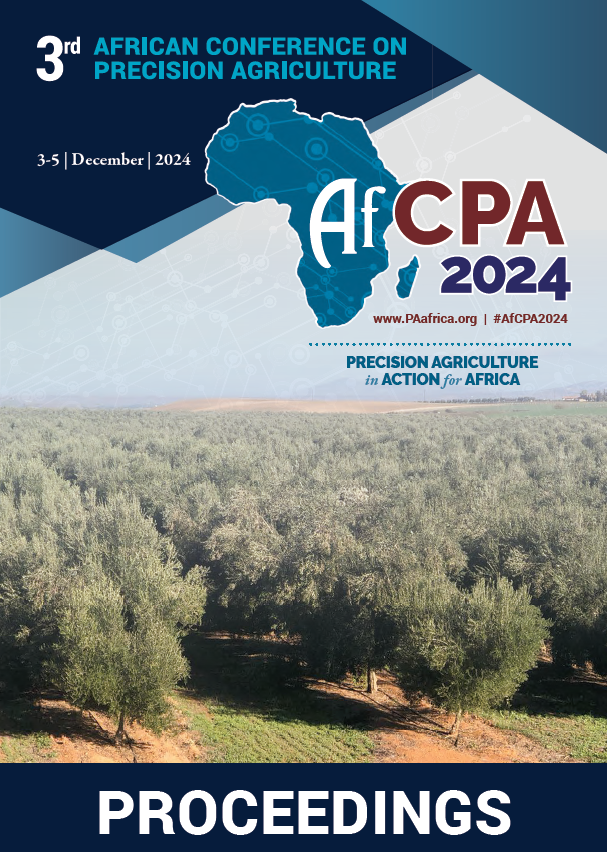Download the Conference Proceedings
Proceedings
Authors
| Filter results8 paper(s) found. |
|---|
1. Estimating greensnap yield damage with canopy reflectance: a case studyGrain yield reduction caused by storm-induced plant breakage (green snap) occurs often in corn fields. With climate change and an increasing frequency in the occurrence of extreme weather events, it is essential to develop methods that can accurately estimate green snap damage, so growers can be properly compensated by insurance companies for yield loss. Because plant breakage also affects crop canopy reflectance, this case study aimed to characterize the changes in crop canopy reflectance... G. Dias paiao, T.J. Nigon, F.G. Fernández, C. Cummings, S.L. Naeve |
2. GESTION STRATEGIQUE DES NUTRIMENTS POUR L’AMELIORATION DU RENDEMENT ET DE LA PROFITABILITE ECONOMIQUE DU GOMBO (Abelmoschus esculentus L.) SUR LES SOLS FERRALITIQUES AU SUD TOGODes stratégies efficientes de gestion des nutriments sont indispensables pour une production agricole améliorée et durable. La performance du gombo (Abelmoschus esculentus L.) a été évaluée sous cinq approches de fertilisation dans un cycle de deux cultures successives à la Station d’expérimentations agronomiques de l’Ecole Supérieure d’Agronomie de l’Université de Lomé (SEA/ESA/UL),... K. Kotchadjo, J.M. Sogbedji |
3. Tomato yield and economic performance under organic and mineral fertilizer applications in coastal TogoResearch efforts towards enhancing vegetables production are still needed in Togo. We assessed tomato (Solanum lycopersicum) yield and associated economic returns under three soil fertility management strategies in a 3-yr period study. Three tomato varieties were used including: MONGAL-F1 (V1), SUMO-F1 (V2) and COBRA 26-F1 (V3). The fertilization regimes were: no fertilizer application as the control (F1), application of 200 kg of N15P15K15 + 100... J.M. Sogbedji, M. Lare |
4. The Yield Gap In Africa: Closing the gap through soil attributes management using remote sensing & Precision Agriculture Approaches at the field scaleIn Africa, which has the most population growth in the world, the agricultural system is characterized by the predominance of smallhoder farmers. In order to cope with intense population growth and increased production costs through yield gap closing. Yield gap is defined as the difference between potential yield and actual yield and is an inevitable method to improve yields while decreasing the environmental impacts of agricultural systems. The variability of yields is strongly controlled by... K. Khechba, A. Laamrani, A. Chehbouni, D. Dhiba, K. Misbah |
5. LiDAR-based soybean crop segmentation for autonomous navigationThe technological advances in the last few decades have greatly changed agricultural operations. In order to became safer, more profitable, efficient, and sustainable, modern farms have adopted the use of sophisticated technologies, such as robots, sensors, aerial images, and GNSS (Global Navigation Satellite System). These technologies not only increase the crop productivity, but also reduce the wide use of water, fertilisers, and pesticides. Due to this, they reduce costs and negative environmental... V.A. Higuti, A.E. Velasquez, M.V. Gasparino, D.V. Magalhães, M. Becker, D.M. Milori, R.V. Aroca |
6. Soil organic carbon mapping in Tunisia: comparison of different interpolation methodsSoil organic carbon (SOC) stock is an important carbon pool in terrestrial ecosystems. It plays an important role in agricultural productivity and is often used as a key indicator of soil quality whether for soil fertility or climate regulation. SOC stocks are difficult to estimate due to the large spatial variability. In this way, many different techniques have been conducted for predicting and mapping SOC content. However, although numerous techniques are in use, there is still debate on which... M. Barbouchi, H. Bahri, A. Souissi, H. Cheikh m'hamed, M. Annabi |
7. Crop monitoring and forecasting system based on cloud data and capabilitiesVarious systems for crop monitoring & forecasting, using satellite images and meteorological data, exist around the world. Their complexity differs from one system to another, according to the temporal and spatial scale and according to the objectives assigned to them. Among the well known are the European Monitoring Agricultural ResourceS system, the USDA system of the Foreign Agricultural Service, the Moroccan CGMS system, the Belgian CGMS system and the Chinese CropWatch system. The... |
8. Effects of Adopting Fertilizer Management Practices on Yield in Maize-Based Systems of Embu County: an Instrumental Variable Regression ApproachFertilizers play an important role in maize production and global food security, contributing significantly to yield increases. However, continuous rise in fertilizer prices has resulted in inflated costs, leading to unaffordability and suboptimal utilization. Inefficient use by farmers has hindered yield potential and increased environmental risks. Additionally, farmers' limited knowledge and awareness of optimal nutrient requirements, timing, application rates, and placement techniques... M. Gitau, R.A. Nyikal, , O. Kitonyo |
